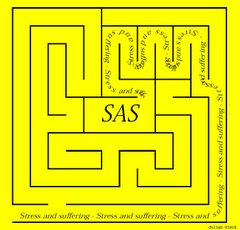I have been exploring this for my work. I found some guidance here. I am including some details here.
data drug;
input drug$ x r n;
cards;
A .1 1 10
A .23 2 12
A .67 1 9
B .2 3 13
B .3 4 15
B .45 5 16
B .78 5 13
C .04 0 10
C .15 0 11
C .56 1 12
C .7 2 12
D .34 5 10
D .6 5 9
D .7 8 10
E .2 12 20
E .34 15 20
E .56 13 15
E .8 17 20
;
proc genmod data=drug;
class drug;
model r/n=x drug / dist=binomial link=logit;
estimate 'A vs E' drug 1 0 0 0 -1/exp;
run;
proc logistic data=drug;
class drug/param=ref;
model r/n=x drug;
run;
/* generates dummy variables coded as follows
drug A 1 0 0 0
B 0 1 0 0
C 0 0 1 0
D 0 0 0 1
E 0 0 0 0 */
proc logistic data=drug;
class drug;
model r/n=x drug;
run;
/* generates dummy variables coded as follows
Class Value Design Variables
drug A 1 0 0 0
B 0 1 0 0
C 0 0 1 0
D 0 0 0 1
E -1 -1 -1 -1
*/
However, the results (Odds ratio) are going to be the same. Accessible help on writing contrast statements is here.
Thursday, April 5, 2007
Monday, April 2, 2007
Proc tabulate/proc report
I have been trying to learn these new tools.
Here is a pdf with clear instructions and uses of both.
Some available options are ACROSS, ANALYSIS, CENTER, COLOR, COMPUTED, CSS, CV, DESCENDING, DISPLAY, EXCLUSIVE, F, FLOW, FORMAT, GROUP, ID, ITEMHELP, LEFT, MAX, MEAN, MEDIAN, MIN, MISSING, N, NMISS, NOPRINT, NOZERO, ORDER, P1, P10, P25, P5, P50, P75, P90, P95, P99, PAGE, PCTN, PCTSUM, PRELOADFMT, PRT, Q1, Q3, QRANGE, RANGE, RIGHT, SPACING, STD, STDERR, STYLE, SUM, SUMWGT, T, USS, VAR, WEIGHT, WGT, WIDTH.
Here is a pdf with clear instructions and uses of both.
Some available options are ACROSS, ANALYSIS, CENTER, COLOR, COMPUTED, CSS, CV, DESCENDING, DISPLAY, EXCLUSIVE, F, FLOW, FORMAT, GROUP, ID, ITEMHELP, LEFT, MAX, MEAN, MEDIAN, MIN, MISSING, N, NMISS, NOPRINT, NOZERO, ORDER, P1, P10, P25, P5, P50, P75, P90, P95, P99, PAGE, PCTN, PCTSUM, PRELOADFMT, PRT, Q1, Q3, QRANGE, RANGE, RIGHT, SPACING, STD, STDERR, STYLE, SUM, SUMWGT, T, USS, VAR, WEIGHT, WGT, WIDTH.
Sunday, April 1, 2007
Macro to output only relevant results to ods
/** following macro runs logistic regression and outputs the results from only the relevant variables to the html file. In this case, I am running regression with various variables but keeping age in all the models. Age is not the variable of interest. */
%macro jncht(dataname,var1);
title "Age and sex adjusted &var1";
ods select OddsRatio ParameterEstimates;
proc logistic data=&dataname ;
model jncht=&var1 ahage ahsex ;
ods output OddsRatios=orrr;
ods output ParameterEstimates=Param;
run;
data param;
set param;
drop DF Estimate StdErr;
run;
proc sort;
by variable;
data orrr;
set orrr;
variable=effect;
drop effect;
proc sort;
by variable;
run;
data new;
merge param orrr;
by variable;
run;
%let cuts=%SUBSTR(&var1,1,4);
ods html select all;
title " age and sex adjusted &var1";
proc print data=new;
var variable OddsRatioEst LowerCL UpperCL ProbChiSq;
where variable like "%NRBQUOTE(%)&cuts%NRBQUOTE(%)";
run;
ods html exclude all;
proc datasets;
delete param orrr new;
%mend ;
Invocation of this macro.
/*include the following statement in the beginning of the program*/
ods html file ="%sysfunc
(reverse(%sysfunc(substr(%sysfunc(reverse(%sysfunc(reverse(%scan(%sysfunc(reverse(%sysfunc(getoption(sysin)))),1,/))))),5)))).html"
STYLE=MINIMAL;
data...;
.
.
.;
%jncht(trott1,&wstci_)
/*Where &wstci_ is a macro variable and equals 'wstci1 wstci2 wstci3'. */
%macro jncht(dataname,var1);
title "Age and sex adjusted &var1";
ods select OddsRatio ParameterEstimates;
proc logistic data=&dataname ;
model jncht=&var1 ahage ahsex ;
ods output OddsRatios=orrr;
ods output ParameterEstimates=Param;
run;
data param;
set param;
drop DF Estimate StdErr;
run;
proc sort;
by variable;
data orrr;
set orrr;
variable=effect;
drop effect;
proc sort;
by variable;
run;
data new;
merge param orrr;
by variable;
run;
%let cuts=%SUBSTR(&var1,1,4);
ods html select all;
title " age and sex adjusted &var1";
proc print data=new;
var variable OddsRatioEst LowerCL UpperCL ProbChiSq;
where variable like "%NRBQUOTE(%)&cuts%NRBQUOTE(%)";
run;
ods html exclude all;
proc datasets;
delete param orrr new;
%mend ;
Invocation of this macro.
/*include the following statement in the beginning of the program*/
ods html file ="%sysfunc
(reverse(%sysfunc(substr(%sysfunc(reverse(%sysfunc(reverse(%scan(%sysfunc(reverse(%sysfunc(getoption(sysin)))),1,/))))),5)))).html"
STYLE=MINIMAL;
data...;
.
.
.;
%jncht(trott1,&wstci_)
/*Where &wstci_ is a macro variable and equals 'wstci1 wstci2 wstci3'. */
Wildcards in different situations
This is a broad area to handle in one posting but here are few links that I found useful:
Using wildcards to read many files into one SAS data set
Matching with a wildcard using Perl regular expression A possible problem with this method is inability of this method to handle macro variables.
Matching with like and percent (%) It is used in the next post.
Using wildcards to read many files into one SAS data set
Subscribe to:
Posts (Atom)
